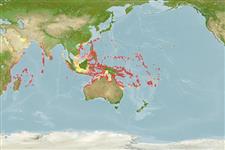Classification / Names
Common names from other countries
Main reference
Size / Weight / Age
Max length : 2.5 cm SL male/unsexed; (Ref. 48637)
Environment
Marine; reef-associated; depth range 0 - 40 m (Ref. 86942)
Climate / Range
Tropical, preferred ?; 30°N - 27°S, 31°E - 168°W
Distribution
Short description
Dorsal
spines
(total): 6 - 7;
Dorsal
soft rays
(total): 8-10;
Anal
spines: 1;
Anal
soft rays: 8 - 9. This species is distinguished by the following characters: cephalic sensory-canal pore system without the NA, PITO & IT pores; dorsal/anal-fin formula 9/8; the fifth pelvic-fin ray 50-80% of the fourth ray; unbranched pectoral rays; caudal fin base with pale-edged black spot (Ref. 107299).
IUCN Red List Status (Ref. 115185)
Threat to humans
Harmless
Human uses
More information
Common namesSynonymsMetabolismPredatorsEcotoxicologyReproductionMaturitySpawningFecundityEggsEgg development
ReferencesAquacultureAquaculture profileStrainsGeneticsAllele frequenciesHeritabilityDiseasesProcessingMass conversion
Tools
Special reports
Download XML
Internet sources
Estimates of some properties based on models
Phylogenetic diversity index
PD50 = 0.5000 many relatives (e.g. carps) 0.5 - 2.0 few relatives (e.g. lungfishes)
Trophic Level
3.1 ±0.3 se; Based on size and trophs of closest relatives
Resilience
High, minimum population doubling time less than 15 months (Preliminary K or Fecundity.)
Vulnerability
Low vulnerability (10 of 100)
Price category
